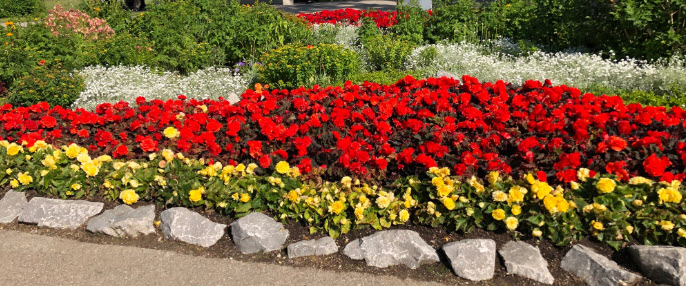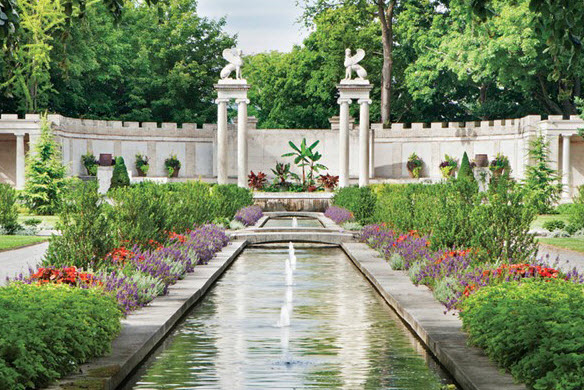“The Garden has for many centuries served as a central element in Muslim culture. The Holy Qur’an, itself, portrays the Garden as a central symbol of a spiritual ideal – a place where human creativity and Divine majesty are fused, where the ingenuity of humanity and the beauty of nature are productively connected. Gardens are a place where the ephemeral meets the eternal, and where the eternal meets the hand of man.”
Mawlana Hazar Imam
Toronto, Canada, May 25, 2015
Speech

The concept of Paradise as a garden is an ancient one pre-dating the Abrahamic faiths by centuries. Paradise, from the ancient Persian paradesion, pairi meaning ‘around’ and daeza meaning ‘to make’ or ‘form’ (a wall), entered into Greek as paradeisos and into Latin as paradisus.

In ancient Persia, Prophet Zoroaster (d. ca. 551 BCE) taught to live in harmony with nature, “to contemplate or mediate upon nature, to observe its beauty, the order and regularity of the natural cycles, and the harmony and interdependence of its manifestations” (Bekhrandnia).
Islamic gardens are also a reflection of Paradise said to await the faithful. The reward for good deeds, according to the Qur’an, is a place of shaded trees, flowing water, gardens with sweet fruits (bustan) and fragrant flowers (gulistan). The Qur’an offers several references to the idea of jannat al-firdaus or gardens of Paradise, ranging from blissful retreat to secure refuge, although it does not give precise guidelines for the creation of one. These images have fed centuries of Muslim art, narrative, and design, as well as spiritual inspiration. Perhaps the concept of Paradise was formed by Arabia’s desert dwellers who had heard of the Persian paradeison. As Muslim rule spread, the diversity of climates and landscapes influenced the built environment.
Gardens also served as final resting places for the dead. The Mughals of India acquired their interest in gardens from the Timurids (ruled Persia and Central Asia 1370–1507) and developed the concept of a memorial garden surrounding a tomb, the most famous being Emperor Humayun’s Tomb and the Taj Mahal, a mausoleum complex commissioned by Shah Jahan (r.1628-1658) in memory of his wife, Arjumand Banu Begam (d.1631), better known by her title “Mumtaz Mahal,” or “the exalted one of the palace.” These garden tombs were metaphors of paradisal imagery and came to symbolise the architectural achievements of the dynasty.
Like all sacred art, the gardens, centred on a spiritual vision of the cosmos, mirror their Heavenly counterparts, aiming to draw the visitor closer to God.
Nasir al-din al-Tusi (d. 1274), one of the most celebrated scholars of the thirteenth century, discusses paradise on earth in his Rawdat al-taslim (Paradise of Submission):
“Both Paradise and Hell are products of man’s mental conceptions and such conceptions are of no more than three categories: sensory (hissi), psychical (nafsi), and intellectual (aqli) conceptions. If his mental conception started out [at the level] of sensory perception and proceeds no further, then such a conception makes of itself a sensible hell for him in his soul, his soul being in his very own hell. If his mental conception begins on a psychical level and proceeds no further, that conception will effect a glimpse of paradise within his soul, his soul sensing the effects of his inner heaven. If his mental conception proceeds from intellectual knowledge and remains at that level, that conception will become a real paradise within the soul for him, his soul being in its very own paradise.
For al-Tusi, paradise is the perpetual state of the genuine seeker after the truth. Whosoever is on the spiritual, actively seeking and finding the inner meaning of the words of scripture is already ‘a denizen of Paradise.‘ As one progresses steadily through various spiritual stages, he encounters a series of paradises, one after the other, which al-Tusi calls ‘paradises of relative perfections,’ until the soul attains ideal perfected conditions which is its ‘real Paradise.’ He describes this ultimate state in terms of ‘the attainment of God in all His aspects,’ ‘the upright (mustaqim) intellect united with the divine volition (amr),’ ‘the gnosis of pure intellect,’ and ‘total freedom of the will (ikhtiyar-i mahd)'” (Surviving the Mongols p 125-126).
Sources:
Nadian Eboo Jamal, Surviving the Mongols, I.B. Tauris in association with The Institute of Ismaili Studies, London, 2002
Ambrin Hayat, Building Heaven on Earth, The Friday Times
Shahin Bekhradnia, Zoroastrianism and the Environment (PDF)
Marianne Barrucand. “The Garden as a Reflection of Paradise,” Islam: Art and Architecture Edited by Markus Hattstein and Peter Delius. Konemann, 2000
Patrick Hunt, Persian Paradise Gardens: Eden and Beyond as Chahar Bagh, Electrum Magazine
